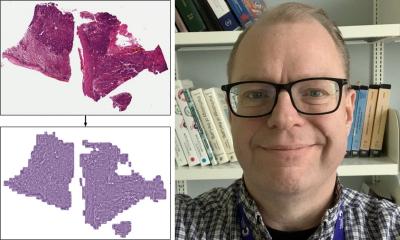Article • Experience report from Portugal
Going digital: no reason to delay
The future of pathology is digital – for many departments, the transformation requires major modifications but promises significant advantages. Speaking to the 8th Digital Pathology and AI Congress in London, Professor Catarina Eloy outlined the vital elements for successful transformation towards full digital pathology implementation.
Report: Mark Nicholls
Image Source: Sarahkayb, Breast MetaplasticCarcinoma MP CTR (2), CC BY-SA 4.0 ; Pixabay/Gerd Altmann; Mashup: EH
For her presentation, the expert shared insights from the successful and effective introduction of digital pathology at her own institution; the Institute of Molecular Pathology and Immunology of the University of Porto (IPATIMUP) in Portugal. The efforts, though considerable, had led to a ‘new standard for primary histological diagnosis’ and ‘a relevant improvement in healthcare,’ she emphasised.
Highlighting the importance of adopting a new approach, with a focus on workstations and workflow within the implementation process, Prof Eloy said: ‘Digital transformation for primary diagnosis has to be a holistic concept that complements innovative interventions in all areas of the pathology laboratory.’ To create optimal pre-analytic conditions of the sample, optimisation, and automation of the lab workflow with strict quality control and validation policies and operations centres on the LIS (Laboratory Information System) are critical, she elaborated.
Getting started

Digital pathology, while being a cost-effective model with significant, direct, and parallel achievements, must be backed by a safe and efficient methodology, Professor Eloy stated, referencing the initial stages of the four-year digital transformation process at IPATIMUP in 2016. First steps involved optimisation of scanners, workstations, and workflows as well as re-design of the lab layout with an assessment area. ‘All areas converge to the scanning area which is located in the heart of the lab,’ she said. ‘That required some extensive reorganisation of space. The tracking system was probably the most relevant measure we adopted through these first years to have a good digital pathology workflow.’
Once fully digital and paper-free, the laboratory retained the same turnaround times with everything standardised to ensure no errors or lost specimens, Prof Eloy reported. A key ingredient for the successful digitisation of the department was the involvement of the whole team, particularly in the training of technicians and pathologists, along with improvements and automation of the pathologist and technician workstations in terms of equipment, environment, ergonomics, space and workload management. The team at IPATIMUP consists of 14 pathologists (with six not using digital pathology), 11 technicians and five administrative staff, working on 38,000 samples a year with a turnaround time of two days and no fall in quality of diagnosis, the expert said.
The road to AI implementation
The next big step for the department is the implementation of artificial intelligence (AI) to assist in routine workflow challenges. Professor Eloy detailed the roadmap of the process, showcasing a paper from her department. Its mission statement reads as follows: ‘The model of digital workflow implementation at IPATIMUP demonstrates that careful planning and adoption of simple measures related to time, spaces, and sample management can be adopted by any pathology laboratory to achieve higher quality and easy digital transformation.’
In summary, Professor Eloy told the congress: ‘After understanding how simple it may be to increase efficiency, quality, and safety in the laboratory workflow, there is not a single reason that justifies delaying in the adoption of the digital management of the pathology laboratory, since it represents a relevant improvement in healthcare.’
Profile:
Professor Catarina Eloy is Head of the Pathology Department and a researcher at IPATIMUP, Porto, Portugal, and Professor at the Faculty of Medicine of Porto University. She is also President of the European Society of Digital and Integrative Pathology and Vice-President of the Portuguese Society of Anatomic Pathology.
03.03.2022










